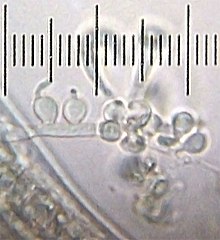


Nematophagous fungi are carnivorous fungi specialized in trapping and digesting nematodes. More than 700 species are known.[1] Species exist that live inside the nematodes from the beginning and others that catch them, mostly with glue traps or in rings, some of which constrict on contact. Some species possess both types of traps. Another technique is to stun the nematodes using toxins, a method employed by Coprinus comatus, Stropharia rugosoannulata, and the family Pleurotaceae.[2] The habit of feeding on nematodes has arisen many times among fungi, as is demonstrated by the fact that nematophagous species are found in all major fungal groups.[3] Nematophagous fungi can be useful in controlling those nematodes that eat crops. Purpureocillium, for example, can be used as a bio-nematicide.
- ^ Soares, Filipe (5 June 2018). "Nematophagous fungi: Far beyond the endoparasite, predator and ovicidal groups". Agriculture and Natural Resources. 52: 1–8. Retrieved 10 November 2024.
- ^ Thorn, R. Greg; Moncalvo, Jean-Marc; Reddy, C. A.; Vilgalys, Rytas (2000). "Phylogenetic Analyses and the Distribution of Nematophagy Support a Monophyletic Pleurotaceae within the Polyphyletic Pleurotoid-Lentinoid Fungi". Mycologia. 92 (2): 241–252. doi:10.2307/3761557. JSTOR 3761557.
- ^ Nordbring-Hertz, Birgit; Jansson, Hans-Börje; Tunlid, Anders (2011). "Nematophagous fungi". eLS. doi:10.1002/9780470015902.a0000374.pub3. ISBN 9780470016176.